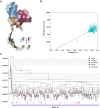Genomic epidemiology and evolutionary analysis during XBB.1.16-predominant periods of SARS-CoV-2 omicron variant in Bangkok, Thailand: December 2022-August 2023
- PMID: 38182705
- PMCID: PMC10770311
- DOI: 10.1038/s41598-023-50856-0
Genomic epidemiology and evolutionary analysis during XBB.1.16-predominant periods of SARS-CoV-2 omicron variant in Bangkok, Thailand: December 2022-August 2023
Abstract
The growing occurrence of novel recombinants, such as XBB.1.16, has emerged and become predominant, raising concerns about the impact of genomic recombination on the evolution of severe acute respiratory syndrome coronavirus 2 (SARS-CoV-2). This study investigated the molecular epidemiological trends and evolution of the Omicron XBB.1.16 epidemic in Bangkok between December 2022 and August 2023. Partial spike and complete genome sequencing of SARS-CoV-2 samples collected from collaborating hospitals were performed. The analysis of 491 partial spike sequences identified 15 distinct lineages, with XBB.1.16 dominating the lineages beginning in March 2023. Phylogenetic analysis revealed at least four distinct XBB.1.16 lineages, suggesting multiple independent introductions into Bangkok. The estimated emergence of XBB.1.16 occurred approximately in January 2022, with an evolutionary rate of 0.79 × 10-3 substitutions per site per year. Monitoring the genomic epidemiology and evolution of XBB.1.16 is vital for the early detection of new strains or emerging variants, which may guide vaccine design and the inclusion of new vaccine strains.
© 2024. The Author(s).
Conflict of interest statement
The authors declare no competing interests.
Figures



References
-
- World Health Organization. COVID-19 Weekly Epidemiological Update Edition 76, published 25 January 2022.file:///C:/Users/ASUS/Downloads/20220125_Weekly_Epi_Update_76.pdf (2022).
-
- World Health Organization. COVID-19 Weekly Epidemiological Update Edition 74, published 11 January 2022. file:///C:/Users/ASUS/Downloads/20220111_Weekly_Epi_Update_74.pdf (2022).
-
- World Health Organization. COVID-19 Weekly Epidemiological Update Edition 73, published 6 January 2022. file:///C:/Users/ASUS/Downloads/20220106_Weekly_Epi_Update_73–1.pdf (2022).
MeSH terms
Substances
Supplementary concepts
LinkOut - more resources
Full Text Sources
Medical
Miscellaneous

